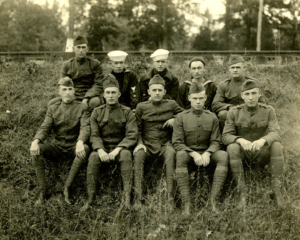Elon College and the First World War, part 4: After the War
By Randall Bowman, Archivist and Assistant Librarian.
In December 1918, the SATC unit at Elon was officially disbanded; members of the company were discharged, and the officers who had trained them departed just before Christmas, to be reassigned by the Army.
In May 1919, at the end of the academic year, President Harper informed the Board of Trustees that the college was in debt due to the cost of housing the SATC unit. The cost of hosting the company had exceeded the War Department’s payments to the college by $14,065.05 ($233,368.53 in 2017 dollars). College officials reached a compromise with the U.S. Government that reduced the deficit to $4,896.86 ($81,249.13 in 2017), still a large sum of money for the small college.
Over the course of the following year, things began to return to normal at Elon. Many college activities that had been suspended during the war resumed; the PhiPsiCli yearbook, which had not been published in 1917 or 1918, was published again in 1920 with an edition dedicated to those members of the Elon community who had given their lives during the war. There are four known Elon casualties from World War I: Charles N. Whitelock, Red Cross Ambulance Corps; Sergeant W. F. Odom, U. S. Army, one of Elon’s first-day volunteers; Sergeant H. H. Barber, also U. S. Army; and Captain John Carl Miller, U. S. Army Air Corps, an aviator who was shot down. All three men were wounded in action but did not die until after hostilities had ceased.
Another change the college faced was a new type of student at Elon; in the fall of 1919, veterans of the World War began enrolling at Elon, as well as at colleges and universities all over the United States. Their numbers were small compared to the numbers that would enroll through the GI Bill following World War II a generation later, but they were still a noticeable presence on college campuses. At Elon, a group of veterans who had served abroad organized a club called “The Overseas Men”. These former soldiers and sailors posed on the railway embankment in their uniforms for their yearbook photo, which also appeared in the 1920 PhiPsiCli.

The arrival of these veterans on Elon’s campus led to another change: the birth of what would become the Student Government Association. Having gone through military training, these veterans were older, more mature, and much more independent than traditional college students. Some had married during the war. Therefore, they had to be treated differently than students who came to college straight from high school. Although the college had previously instituted a form of student government prior to the war, it became evident a new system was needed to take into account the maturity and experience of these veterans.
Recognizing this, in January 1919 the Elon College faculty authorized the creation of a student senate. A new constitution, “The Constitution for Student Self-Government for Men in Elon College” created the Student Senate; it included rules for the election of officers. The bylaws also empowered the senate to regulate conduct of students, and to hear cases of infractions of the rules. It included a provision that any student found guilty of cheating after pledging the work was his own be expelled. This is the beginning of the Honor System at Elon.
Soon afterwards, a separate constitution was enacted for female students; it was entitled, “Agreement Concerning Self-Government of the Young Women Students of Elon College”. It created a similar governing body for the women, along with by-laws with more regulations for female students than for the males. Many years later, the two senates were merged into one governing body for all students.
Twenty years after the Treaty of Versailles officially ended the First World War in 1919, the Second World War would begin. This much larger and even more horrific conflict would overshadow the first. But the events of 1917-1919 have not been forgotten at Elon. Over the years, there were various memorials to the war. In 1925, two memorial trees, both maples, were planted on campus in memory of those who died in the World War. But the most visible memorial to the war would come in 1950 with the dedication of the new Alumni Memorial Gymnasium, dedicated in honor of the Elon men and women who served in both world wars. Today Alumni Gym has a plaque inside with the names of the four Elon dead from World War I, along with the names of those who perished in World War II.
Leave a Reply